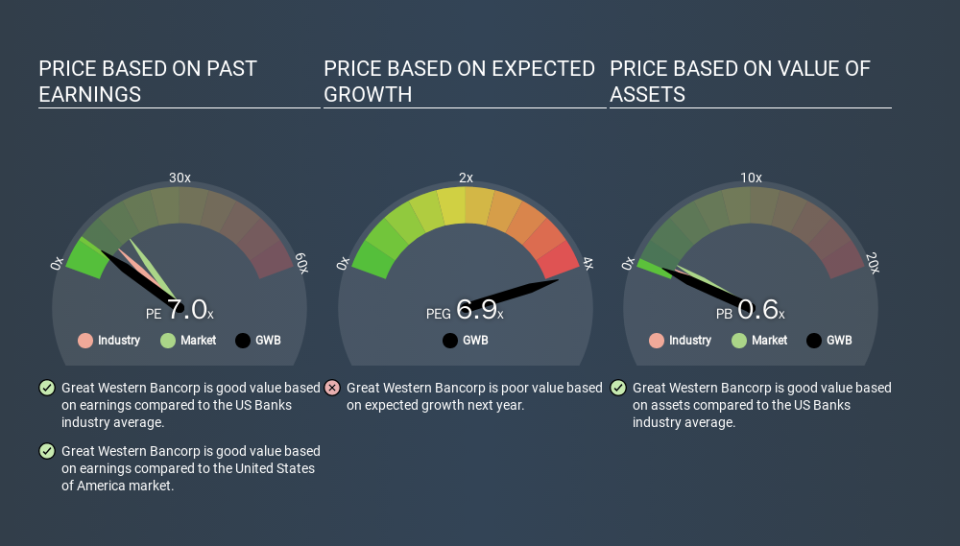How Does Great Western Bancorp's (NYSE:GWB) P/E Compare To Its Industry, After The Share Price Drop?

Unfortunately for some shareholders, the Great Western Bancorp (NYSE:GWB) share price has dived 34% in the last thirty days. That drop has capped off a tough year for shareholders, with the share price down 42% in that time.
All else being equal, a share price drop should make a stock more attractive to potential investors. In the long term, share prices tend to follow earnings per share, but in the short term prices bounce around in response to short term factors (which are not always obvious). So, on certain occasions, long term focussed investors try to take advantage of pessimistic expectations to buy shares at a better price. Perhaps the simplest way to get a read on investors' expectations of a business is to look at its Price to Earnings Ratio (PE Ratio). Investors have optimistic expectations of companies with higher P/E ratios, compared to companies with lower P/E ratios.
See our latest analysis for Great Western Bancorp
Does Great Western Bancorp Have A Relatively High Or Low P/E For Its Industry?
Great Western Bancorp's P/E of 7.00 indicates relatively low sentiment towards the stock. If you look at the image below, you can see Great Western Bancorp has a lower P/E than the average (9.7) in the banks industry classification.
This suggests that market participants think Great Western Bancorp will underperform other companies in its industry. Since the market seems unimpressed with Great Western Bancorp, it's quite possible it could surprise on the upside. If you consider the stock interesting, further research is recommended. For example, I often monitor director buying and selling.
How Growth Rates Impact P/E Ratios
P/E ratios primarily reflect market expectations around earnings growth rates. If earnings are growing quickly, then the 'E' in the equation will increase faster than it would otherwise. That means unless the share price increases, the P/E will reduce in a few years. And as that P/E ratio drops, the company will look cheap, unless its share price increases.
Great Western Bancorp saw earnings per share decrease by 2.3% last year. But over the longer term (5 years) earnings per share have increased by 10%.
Remember: P/E Ratios Don't Consider The Balance Sheet
One drawback of using a P/E ratio is that it considers market capitalization, but not the balance sheet. Thus, the metric does not reflect cash or debt held by the company. Theoretically, a business can improve its earnings (and produce a lower P/E in the future) by investing in growth. That means taking on debt (or spending its cash).
Spending on growth might be good or bad a few years later, but the point is that the P/E ratio does not account for the option (or lack thereof).
So What Does Great Western Bancorp's Balance Sheet Tell Us?
Net debt is 40% of Great Western Bancorp's market cap. While it's worth keeping this in mind, it isn't a worry.
The Bottom Line On Great Western Bancorp's P/E Ratio
Great Western Bancorp trades on a P/E ratio of 7.0, which is below the US market average of 13.3. Since it only carries a modest debt load, it's likely the low expectations implied by the P/E ratio arise from the lack of recent earnings growth. What can be absolutely certain is that the market has become more pessimistic about Great Western Bancorp over the last month, with the P/E ratio falling from 10.6 back then to 7.0 today. For those who prefer to invest with the flow of momentum, that might be a bad sign, but for deep value investors this stock might justify some research.
Investors should be looking to buy stocks that the market is wrong about. As value investor Benjamin Graham famously said, 'In the short run, the market is a voting machine but in the long run, it is a weighing machine. So this free visualization of the analyst consensus on future earnings could help you make the right decision about whether to buy, sell, or hold.
Of course, you might find a fantastic investment by looking at a few good candidates. So take a peek at this free list of companies with modest (or no) debt, trading on a P/E below 20.
If you spot an error that warrants correction, please contact the editor at editorial-team@simplywallst.com. This article by Simply Wall St is general in nature. It does not constitute a recommendation to buy or sell any stock, and does not take account of your objectives, or your financial situation. Simply Wall St has no position in the stocks mentioned.
We aim to bring you long-term focused research analysis driven by fundamental data. Note that our analysis may not factor in the latest price-sensitive company announcements or qualitative material. Thank you for reading.

